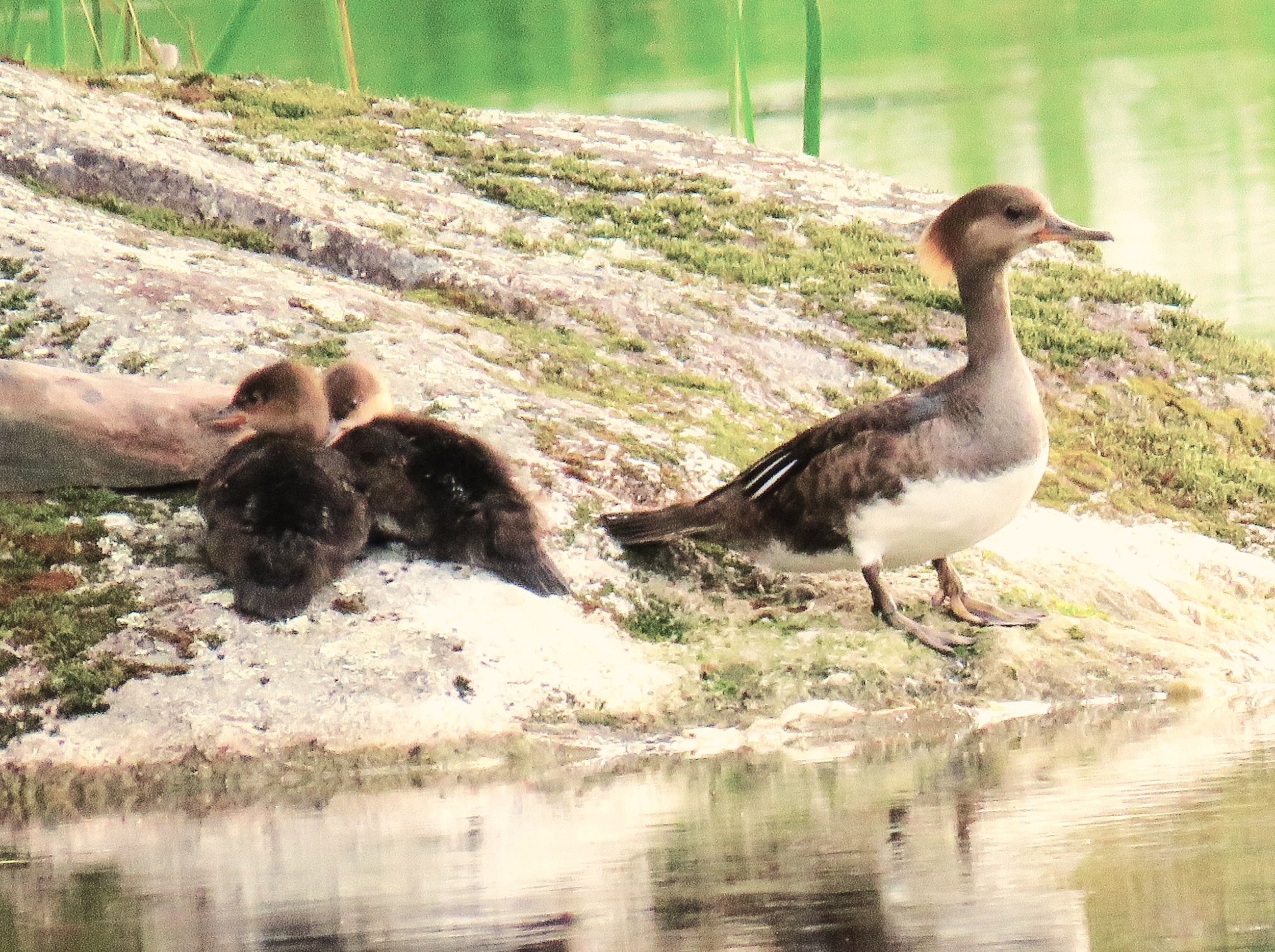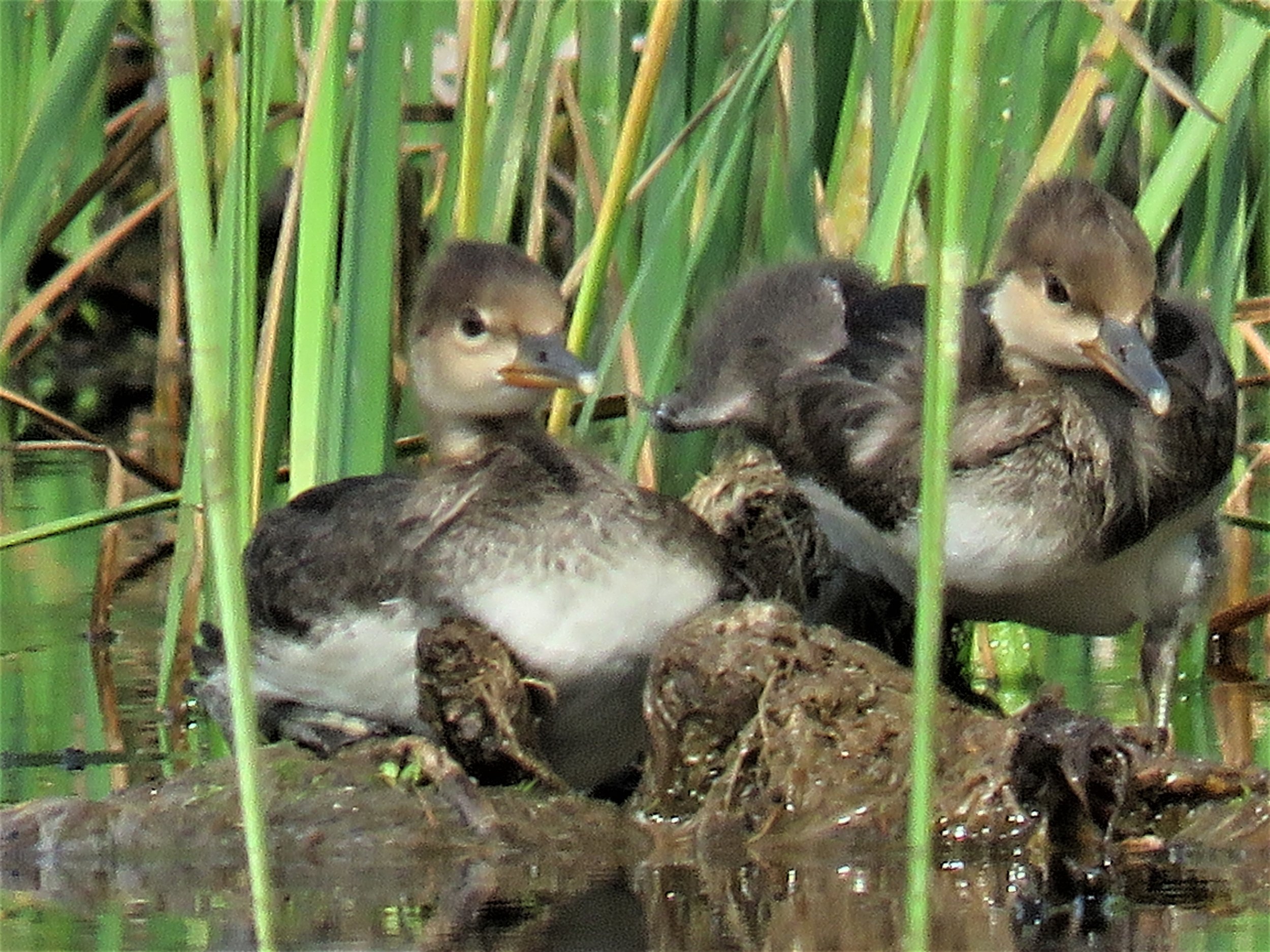Phenological Phacts and Photos w/ Carl Martland / July 2022
Merganser Family
Phenology – “a branch of science concerned with the relationship between climate and periodic biological phenomena (as the migration of birds or the flowering and fruiting of plants).”
Mergansers
Mergansers are crested, thin-billed diving ducks, and the males are among our most colorful and beautiful birds, only slightly less entrancing than wood ducks and harlequin ducks. Red-breasted and common mergansers are about the size of a mallard; the hooded mergansers are a little smaller.
Three species of mergansers can be seen in New England. Red-breasted mergansers are common along the coasts, while common mergansers are mostly found on large, clear lakes and rivers. Hooded mergansers prefer small, wooded ponds with nearby dead trees that provide nesting cavities. You’ll need to travel a hundred miles to York or Portsmouth before you’ll have much chance to see the red-breasted mergansers, but you can see common mergansers in Coffin Pond and the Connecticut River, and you can see hooded mergansers in many of the small ponds found in the North Country.
[1] Photos and text by Carl D. Martland, founding member of ACT, long-time resident of Sugar Hill, and author of Sugar Hill Days: What’s Happening in the Fields, Wetlands, and Forests of a Small New Hampshire Town on the Western Edge of the White Mountain. Quotations from his book and his journals indicate the dates of and the situations depicted in the photos.
Mergansers in the Pond
Hooded mergansers have successfully raised families in our one-acre pond nine times in the last twenty years. They arrive at the pond soon after the ice begins to break up. One year, two pairs flew in, and another year two males accompanied a single female, but usually it’s just a pair. If they decide to stay, the pair will be seen many times for a week or two, and then the male departs, leaving the female alone with her eggs and her dreams.
Let’s follow the family that made the pond their home during the spring and summer of 2019. In mid-April of that year, when the pond was still almost completely covered with ice, a pair of mergansers landed in a tiny opening only a few yards wide:
April 19, 2019, 70 degrees, mostly cloudy. The pond is only 10% ice-free, but 80% of the ice is rotten grey. A pair of hooded mergansers are having no trouble breaking through.
Over the next three weeks, I would often see the pair swimming, preening or simply floating in the pond. On May 9th, I saw the pair fly off, and that was the last time I saw the male in 2019. This was not unexpected, as May 13th is the latest date that I have ever seen a male merganser in our pond in the spring.
April 25, 2019, 3:51pm. I took a photo of a male hooded merganser preening in the pond.
May 9, 2019. A pair of hooded mergansers flew off when I approached the pond this morning.
During May and early June, the female merganser could be seen most afternoons swimming slowly around the pond, diving from time to time, possibly to snag one of the wood frog tadpoles from the swarm that slowly moves along the shallow waters not too far from shore. I didn’t discover the tree cavity where she might have made her nest, and I wondered whether or not she even had a nest full of eggs.
Ducklings
Then one day, in my routine walk to the Pond, I was happy find mom taking her new brood for a trip around the pond. For their first swim, the little ducklings stayed bunched together, never more than a yard or two from their mother.
June 11, 2019. The hooded merganser has taken her seven ducklings for a swim in the Pond.
The ducklings followed close to their mother as she slowly swam from the far end of the pond to the large rock at the tip of the Point that my grandson named “Rock Island”. She croaked, and they struggled out of the water, up the gentle slope of Rock Island, and cuddled together in a fuzzy ball no more than a foot wide.
Within just one or two days, the ducklings gain the strength and confidence to stray a little further from their mother. Within a week, mom might be in the center of the pond with three or four of the ducklings, while the others are exploring the cattails maybe ten or twenty yards away. If she senses danger, i.e. if I approach too closely, she begins her rough call, a cross between a quack and a cough, and she continues until her entire brood has joined her.
Unfortunately for the ducklings, predators much more dangerous than me may be nearby, and predation could come from the ground or the air. Otters and weasels visit the pond from time to time, and hawks can be seen circling high in the sky. In 2019, the number of ducklings dropped from seven to three in less than a week. A neighborhood harrier was never indicted, but its behavior certainly made him a prime suspect:
June 21, 2019, 68 degrees, cloudy, 3pm. At 5:15pm, a harrier flew low over the house as we sat on the porch. I went out to the pond, worrying about the merganser family, which turned out to be safe in the center of the pond. However, I heard some cries from the reeds and shrubs at the right of our end, and the harrier flew off holding a small bird in its claws, being chased by several redwing blackbirds.
The drab, splotched colors of the young mergansers and their mother help them disappear from view as soon as they reach the reeds. When they rest in the warmth of Rock Island, the ducklings are unconcerned, but mom keeps a close watch.
June 15, 2019. Mom keeps watch while her three ducklings hide in the reeds.
June 28, 2019. Two ducklings take a break on Rock Island while mom keeps watch over the one still swimming in the Pond.
Within a few weeks, the ducklings start flexing their wings, building up strength and perhaps yearning to fly around like the other birds they see around the Pond. Mom stays with them for a while longer in July, but they are getting big enough to live on their own.
July 5, 2019. The young mergansers have created comfortable depressions where they can sit at the edge of the reeds. Now they are strong enough to try out their wings.
“Make Way for Ducklings”
Once the ducklings are strong enough to walk a quarter mile or so, their mother may lead them off to a different pond. I say this, not only because we have all read “Make Way for Ducklings”, but also because I once saw a wood duck with a train of ducklings walk across our front lawn and on to our pond, presumably coming up from the small pond that is not too far down Pearl Lake Road. I think that a couple of our families of hooded mergansers have completed the opposite trip in recent years. In 2019, however, only the mother departed, and her three young hooded mergansers stayed around the pond until the middle of September.
August 25, 2019. The three young hooded mergansers are now nearly full-size, and they are on their own in the pond.
The mergansers gather together for their fall migration sometime in October. As in the spring, they are most likely to be seen in small flocks at Coffin Pond or Pearl Lake, but once in a while, a few drop in at our small pond. As in the early spring, the males show off their fancy crests and their contrasting patches of color, but now we know that it was the females who stayed around and did what was necessary to help her ducklings learn to live on their own.
October 19, 2018. Two males and a female showed up today at the pond.







